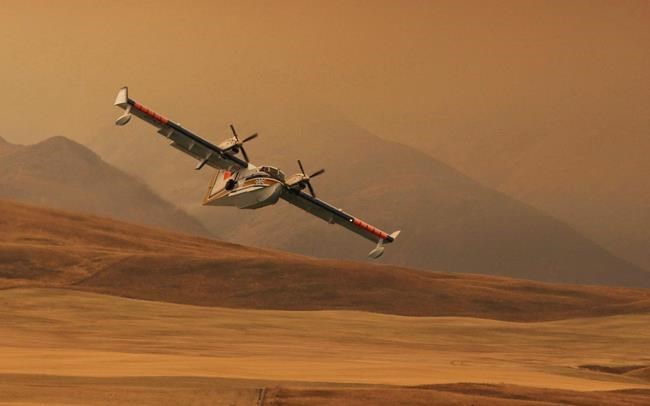MONTREAL — Aviation experts say Canada is losing expertise in the manufacturing of water bombers — just as demand for them is increasing.
The Canadair CL-415, a purpose-built water bomber, was last produced in 2015. That plane and its predecessor — the CL-215 — are the only water bombers used in Quebec and play major roles in the fleets of other provinces.
On Monday, water bombers from Montana were deployed in Quebec to support the province's firefighters and its fleet of 14 CL-415s and CL-215s. Quebec is experiencing its worst fire season on record, following a record fire season in Nova Scotia.
Emergency Preparedness Minister Bill Blair told a news conference earlier this week that the provinces have enough equipment to fight the fires that are raging in several parts of the country. If necessary, he said, Ottawa would try to acquire additional equipment from other countries.
"But we have to know where (the equipment) is and how we can access it very quickly," he said.
But finding planes quickly may be complicated because other countries are also fighting fires, said John Gradek, coordinator of McGill University's aviation management program.
"The northern hemisphere is in the fire season," he said in an interview. "We'll be hard-pressed to find a country that can lend us planes."
Gradek said he believes the provinces should have bought more tanker planes. "In Canada, we have 55 Canadair planes — a combination of CL-215s and CL-415s," he said, adding that "considering the number of fires currently in the country, it's absolutely insufficient."
Some of those planes were built 50 years ago, he said.
"We don't build these planes in Canada anymore … we try to modify, to maintain and update the components of these planes," he said.
Quebec Premier François Legault alluded to the maintenance challenges during a news conference earlier this week, standing in front of a CL-215 that was grounded for repairs.
"When we see a CL-215 that we can't use because of maintenance issues, you have to ask yourself, do we need more mechanics? The answer is probably yes. Do we need to buy some additional new planes? I think that's more the way we have to look at it," he said.
In 2016, Bombardier, which acquired Canadair in the 1980s, sold its water bomber program to British Columbia-based Viking Air.
Viking Air, which plans to build a factory in Western Canada, could begin producing new water bombers in 2027, but those planes probably won't be used to put out forest fires in Canada, Gradek said.
"The company will have the capacity to build 10 planes a year," he said, adding that the first 25 are already intended for Indonesia, France, Spain and other European countries,
He said that if a Canadian province ordered a new CL-415, construction on it wouldn't likely begin before 2030.
"Europeans want the new generation of the Canadair CL-415 and are ready to make major purchases," he said, adding that the first generation of the plane was recognized for its performance around the world.
If the 2023 fire season is an indicator of what's to come, countries will increasingly need this type of plane.
He said he would like to see the federal government support Viking Air, "not only so that it can start producing the CL-415, but also to increase the planned production capacity."
Mehran Ebrahimi, director of the International Aeronautics and Civil Aviation Observatory at Université du Québec à Montréal, said he worries expertise is being lost, particularly in Quebec, since Bombardier ended production of Canadair water bombers.
"We've seen the effects of climate change around the world, so we could have put ourselves in a position not only to produce but also to strategically maintain and preserve our ability to build these aircraft, which require special expertise," said the management professor.
Referring to the CL-215, Ebrahimi said, "these are planes that we produced and we can't repair them? What happened there? Where has the expertise gone in the meantime?"
This report by The Canadian Press was first published June 8, 2023.
Stéphane Blais, The Canadian Press




